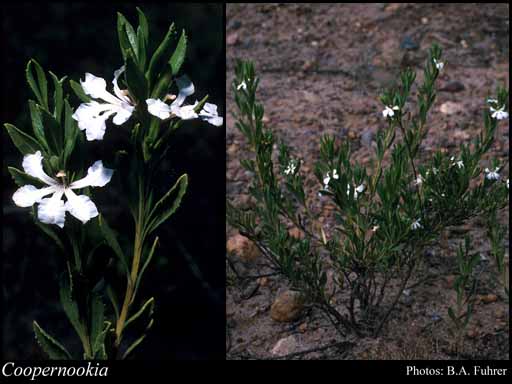- Reference
- Proc.Linn.Soc.New South Wales 92(3):209, fig. 1. (1968)
- Name Status
- Current







Scientific Description
Common name. Coopernookias. Family Goodeniaceae.
Habit and leaf form. Shrubs (undershrubs). Leaves cauline (ass.). Stem internodes solid (ass.). Mesophytic, or xerophytic. Leaves alternate; spiral; petiolate, or subsessile, or sessile; non-sheathing; simple; epulvinate. Leaf blades entire; pinnately veined. Leaves without stipules. Leaf blade margins entire, or serrate, or dentate. Leaves without a persistent basal meristem. Leaf anatomy. Hairs present (often viscid becoming varnished); glandular hairs present; complex hairs present, or absent. Extra-floral nectaries absent (ass.). Stem anatomy. Secondary thickening absent, or developing from a conventional cambial ring.
Reproductive type, pollination. Fertile flowers hermaphrodite. Unisexual flowers absent. Plants hermaphrodite. Entomophilous. Pollination mechanism conspicuously specialized (involving a stylar modification for pollen presentation).
Inflorescence and flower features. Flowers aggregated in ‘inflorescences’; in cymes (in a leafy thyrse), or in racemes. The terminal inflorescence unit cymose, or racemose. Inflorescences terminal, or axillary. Flowers pedicellate, or subsessile (pedicels articulate); bracteate; bracteolate; small to medium-sized; very irregular. The floral asymmetry involving the perianth and involving the androecium. Flowers 5 merous; cyclic; tetracyclic. Free hypanthium absent; adnate to the ovary. Hypogynous disk present, or absent. Perianth with distinct calyx and corolla; (8–)10; 2 -whorled; isomerous, or anisomerous. Calyx present; 5 (ass.); 1 -whorled; gamosepalous; blunt-lobed; tubular. Calyx lobes ovate, or linear. Corolla present; 5; 1 -whorled; not appendiculate; gamopetalous; lobed. Corolla tube adaxially deeply split. Corolla valvate; bilabiate; white (to mauve), or pink. Androecial members definite in number. Androecium 5. Androecial members free of the perianth, or adnate; all equal (ass.); free of one another; 1 -whorled. Androecium exclusively of fertile stamens. Stamens 5. Staminal insertion near the base of the corolla tube. Stamens all more or less similar in shape (ass.); isomerous with the perianth; oppositisepalous (at the base of the corolla); all alternating with the corolla members. Anthers separate from one another; basifixed; dehiscing via longitudinal slits; introrse; tetrasporangiate. Pollen shed in aggregates, or shed as single grains. Gynoecium 2 carpelled. The pistil 2 celled. Gynoecium syncarpous; synstylovarious to eu-syncarpous; superior to inferior. Ovary plurilocular; 2 locular (incompletely); sessile (ass.). Gynoecium stylate. Styles 1; bearing an ‘indusium’ beneath the stigma. Indusium cupular. Styles apical. Stigmas 1; 2 - lobed. Placentation axile. Ovules 2–8 per locule; ascending; arillate; anatropous.
Fruit and seed features. Fruit non-fleshy; dehiscent; a capsule. Capsules valvular. Fruit 2 celled; 2 seeded (or more per cell is the usual). Seeds copiously endospermic. Endosperm oily. Seeds not compressed; wingless. Cotyledons 2. Embryo straight.
Special features. The upper lip of the corolla incorporating 2 members, the lower 3; (posterior, adaxial) lip of the corolla bilobed. Lower (abaxial) lip of the corolla 3 lobed.
Etymology. After Coopernook State Forest, New South Wales, where C. chisolmii is common.
Taxonomic Literature
- Australian Biological Resources Study 1992. Flora of Australia. Volume 35, Brunoniaceae, Goodeniaceae. Australian Govt. Pub. Service.. Canberra..
- Grieve, Brian J.; Blackall, William E. 1982. How to know Western Australian wildflowers : a key to the flora of the extratropical regions of Western Australia. Part IV. University of W.A. Press.. [Perth]..